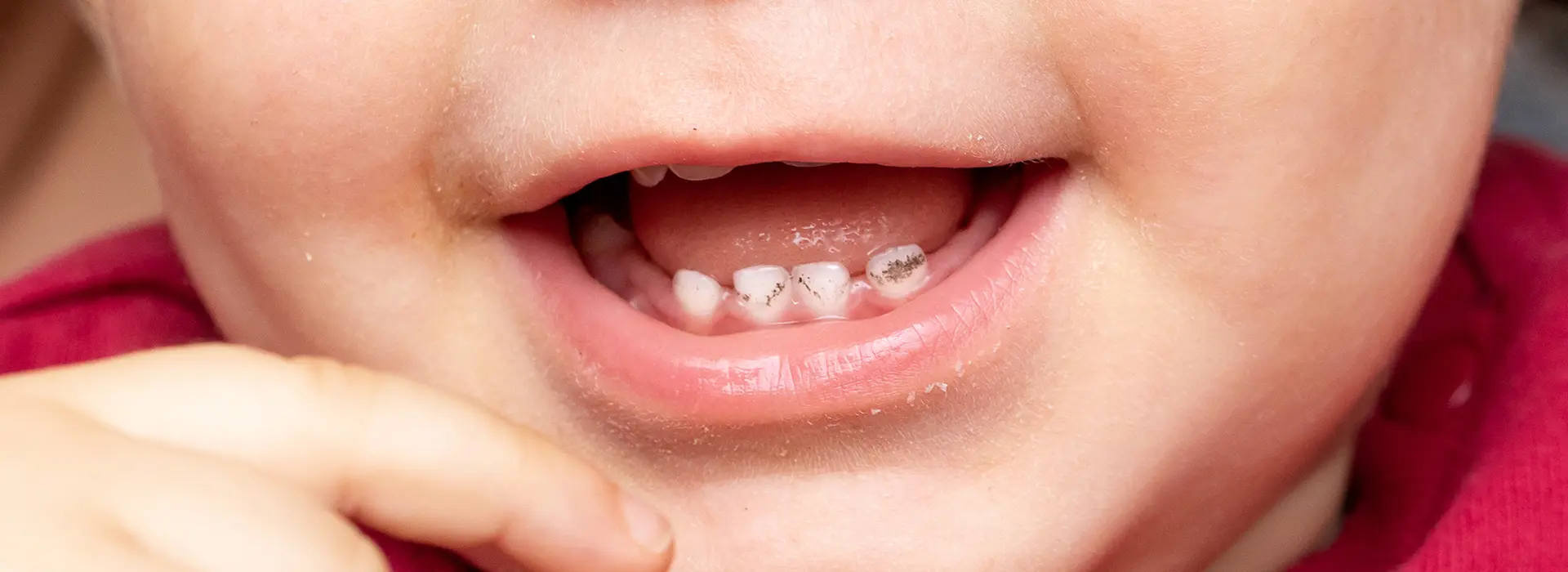Reviewed by Dr. Alan Baughman, DMD, MBA
Reading time: four minutes.
Yellow, brown, or black spots on your baby’s front teeth may not just be a phase, they could be signs of baby bottle syndrome, also called baby bottle tooth decay.
This dental condition affects infants and toddlers, especially if they fall asleep with a bottle or sip sugary drinks throughout the day. Frequent exposure to sugary liquids, including fruit juices, breast milk, and milk in bottles, can create an environment for bacteria and lead to rapid decay.
In this blog, you’ll learn what baby bottle syndrome is, what causes it, how to prevent it, and when to see a dentist for help.
Table of Contents
- What Is Baby Bottle Syndrome?
- How to Prevent Tooth Decay
- What If Your Child Already Has Tooth Decay?
- Protect Your Child’s Smile With Preventative Dental Care
- FAQs About Baby Bottle Syndrome
Key Takeaway
Baby bottle syndrome is a preventable condition caused by frequent exposure to sugary liquids and poor oral hygiene. With early dental visits, good feeding habits, and proper cleaning routines, you can protect your child’s baby teeth from rapid decay and long-term damage..
What Is Baby Bottle Syndrome?
Baby bottle syndrome is a form of early childhood tooth decay caused by frequent, prolonged exposure to milk or sugary drinks. It often starts on the upper front teeth and can spread quickly if not treated.
Milk, formula, juice, or sugar water feed bacteria in the mouth. These bacteria produce acid, which wears away enamel, especially when it sits on the teeth overnight. The result is cavities, discoloration, and visible spots (white or brown) on primary teeth.
Certain habits and routines increase the risk of baby bottle tooth decay:
- Frequent bottle use: Letting a child fall asleep with a bottle or sip on one throughout the day keeps sugar on their teeth and encourages decay.
- Sugary drinks: Juice, soft drinks, sugar water, and even breast milk can contribute, especially if teeth are not rinsed or cleaned afterward.
- Inconsistent oral hygiene: Skipping brushing after feedings allows plaque and bacteria to build up quickly.
- Delayed dental visits: Waiting too long for your child’s first dental appointment can allow small problems to turn into bigger ones.
How to Prevent Tooth Decay
Here are simple steps to prevent it:
- Start cleaning early: Wipe your baby’s gums with a soft cloth after feeding. Once teeth appear clean, use a soft toothbrush and a pea-sized amount of fluoride toothpaste.
- Avoid bedtime bottles: Never let your child sleep with a bottle of milk or liquids containing sugar. Offer plain water instead.
- Encourage open cup use: Transition from bottles to a sippy cup by the first birthday to reduce risk.
- Visit a dentist by age 1: Early visits help establish good habits and allow your dentist to monitor for early signs of caries in children.
What If Your Child Already Has Tooth Decay?
If you notice signs like tooth discoloration, brown or white spots, sensitivity, or small pits in the teeth, it’s important to act quickly. Early treatment can prevent the problem from getting worse and protect the space needed for your child’s permanent teeth to come in properly. The type of care your child needs will depend on how advanced the decay is:
- Fluoride treatments or sealants for early-stage decay
- Composite fillings to repair moderate damage
- Dental crowns for deeper or more severe cavities, especially when a baby tooth is too damaged to restore with a filling
Protect Your Child’s Smile With Preventative Dental Care
Baby bottle syndrome is common, but it’s also preventable.
With early checkups, healthy habits, and guidance from a trusted dental team, you can help your child avoid unnecessary discomfort and long-term dental issues.
If you have noticed spots on your child’s teeth or have questions about caring for their smile, we’re here to help.
To book an appointment at our dental office in Greeley, CO, call (970) 515-3550 or visit us at 3110 67th Ave Pl, Greeley, CO.
FAQs About Baby Bottle Syndrome
Treatment depends on how advanced the decay is. Early stages may be managed with fluoride treatments or dental sealants. If the damage is more extensive, dental bonding or crowns may be needed to restore the teeth. Preventing further decay with proper oral hygiene, limiting sugary drinks, and regular dental visits is key.
Bottle feeding syndrome, also known as baby bottle tooth decay, is a form of early childhood cavities caused by frequent or prolonged exposure to sugary liquids in bottles. It typically affects the front upper teeth and can develop when a child falls asleep with a bottle or sips on it throughout the day.


